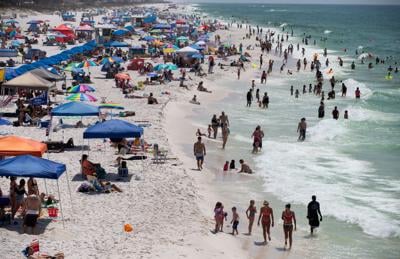The Florida Panhandle, a prime summer vacation destination for thousands of southeast Louisiana residents, is home to six of the Sunshine State's beaches that most often test positive for fecal coliform bacteria, according to a new report from the Environment America Research and Policy Center. Two are in the Pensacola area, four in the Panama City area.
Can't see graph above? Click here.
In the Pensacola area, both Bayou Texar and Bayou Chico empty into Pensacola Bay but neither in the immediate vicinity of a public beach promoted by Visit Pensacola, a nonprofit that promotes tourism. "Due to the known conditions of these two areas, permanent signage has been installed warning of the water conditions," said Darien Schaefer, the organization's president and CEO.
"Visit Pensacola continues to work closely with the Pensacola & Perdido Bays Estuary Program to ensure that our beaches are swimmable for all," Schaefer said. "The Estuary Program and partners are working diligently to make investments in monitoring efforts, identify potential bacterial sources and rectify identified issues through water quality improvement projects. Through these efforts, we will work to ensure that Pensacola area beaches are a safe destination for both visitors and locals, for generations to come."
Fontainebleau State Park in Mandeville a hotspot for contamination
The new report comes from a national study of federal data on water sampling at almost 330 beaches in 29 coastal and Great Lakes states and Puerto Rico. About one in 10 beaches surveyed showed concerning levels of fecal bacteria on at least a quarter of the days they were tested.
In the Panama City area, the report cites beaches at Beach Drive, Delwood, Carl Gray Park and DuPont Bridge.
Fecal bacteria can lead to stomach problems, lung illnesses, ear and eye infections and skin rashes. Common causes for spikes in waterborne bacteria include runoff from streets and other paved surfaces, sewerage overflows, failed septic systems, pet waste and manure and fertilizer from farms.
Threats getting worse as climate change intensifies rain
The threat of fecal bacteria in beachfront water is getting worse as climate change increases the number of hard and heavy rains that flush bacteria into drainage systems and waterways. Environment America recommends a series of steps to curb fecal pollution:
- Policymakers should protect wetlands and other natural areas that absorb runoff, and curb the spread of impervious surfaces such as streets and parking lots. Coastal areas lost about 640,000 acres of wetlands and 10 million acres of forest to development since the mid-1990s, according to the study.
- Wide-ranging sewerage improvements are also needed. Many cities design their systems to overflow into drainage systems and waterways during heavy rains. But with the number of intense rain events on the rise, overflows are happening more frequently. By Environment America’s estimates, overflows are now happening almost 80,000 times per year into U.S. waters.
- Agricultural practices across the United States should be revamped. Large “factory” farms often produce more manure than can be safely stored, the study said. Heavy rains often wash through these manure piles, eventually dumping bacteria and other pathogens into waterways frequented by beach goers.
See how 10 swim spots rate in environmental testing




